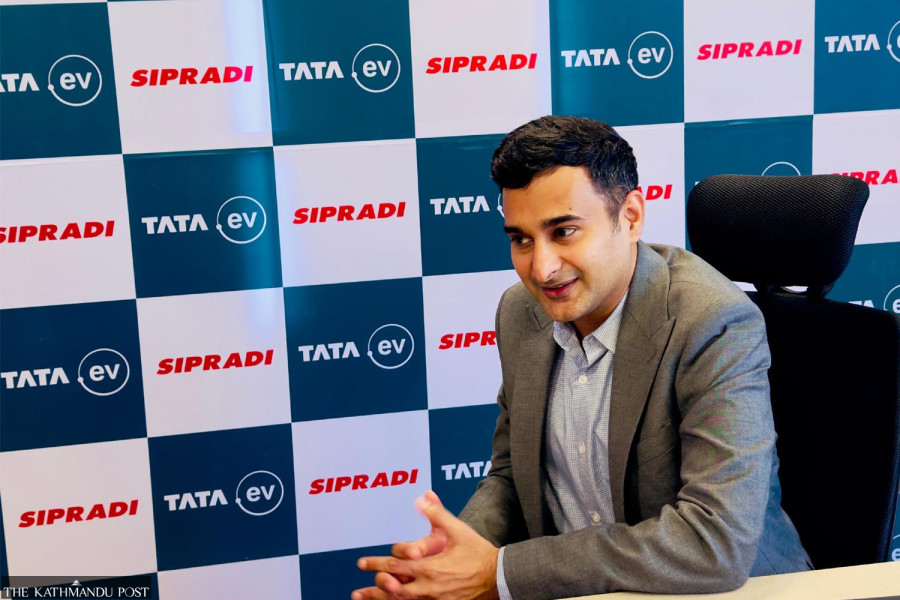Money
‘We were market leader in EVs in Nepal. We would like to regain that spot’
Balaje Rajan, chief strategy officer and vice president for International Business of Tata Passenger Electric Mobility, talks about Nepal’s EV market, ongoing competition with Chinese EVs and the company’s future plans.
Post Report
NADA Auto Show 2024, Nepal’s biggest automobile fair, kicks off Tuesday in Kathmandu. Electric vehicle (EV) producers and representatives are here to tap into Nepal’s booming EV market, which saw 149 percent increase in imports in the last fiscal year, which ended in mid-July. The country brought in 11,701 EVs worth Rs29.48 billion during this period. The Post caught up with Balaje Rajan, chief strategy officer and vice president for International Business of Tata Passenger Electric Mobility, who is currently in Nepal to participate in the auto show, to talk about Nepal’s EV market, ongoing competition with Chinese EVs and the company’s future plans. Excerpts:
How do you observe the Nepali EV market?
Nepal has taken a very progressive stance towards EVs. Roughly 85 percent of the passenger vehicle market here now consists of EVs. It's a significant market for Tata Motors because, as the market leader over the last couple of years, we aim to maintain that spot, and we also believe that our products are perfect for Nepali roads. So, I see Nepal as a very important market. I also see Nepal as one of the benchmark automotive markets in the world where EVs are driving the market.
The presence of Chinese EVs in the Nepali market is increasing faster. How do you view the competition? What are your strategies for staying ahead?
Chinese EVs compete everywhere in the world, including in India. Despite multiple competitors, we have constantly innovated our products, and continue to retain a significant leadership position of about 70 percent plus market share in our home country, India. So, our products are more fit for the kind of use cases people see in Nepal. Our partnership with Sipradi, which has developed charging stations and vehicle servicing ecosystems in Nepal, will be our edge. The strength of our products, plus our partnership with Sipradi, will enable us to continue our success.
Given the differences in terrain and infrastructure between Nepal and India, TATA EV customers complain that the range is not as advertised. How is the company addressing the issue?
We have been communicating the real-world use range and product sales at the dealership. We have to differentiate between the certified range because of the certification methodology. There is a certain ideal test condition which, for statutory or regulatory reasons, we must declare in India. So, we are careful to ensure that that reference is not taken as the real-life range in a Nepal-type condition where the terrain is very different. We are giving a real-life range indication at the point of sale through our partner Sipradi, and we will also, with our current launch and going forward, declare the real-life range in our advertisements. So that customers would know exactly what the specific range is.
What is the share of TATA EV in the Nepali market? Which models are popular with customers?
We have had a tremendous run for about the last twenty months or so, starting with the pro-EV policies coming into effect. We are proud to say that last year, we were the market leaders, and this year as well, we have seen very strong retail growth. We want to regain that spot. When our Nexon was initially launched, followed by Tiago, we had a very good customer response. In the fleet segment, the Express T has a very strong response. We are launching the Punch at the NADA Auto Show, which starts Tuesday, and we expect a strong response. We will continue to bring our new models here, which will continue to be loved by customers.
What are your sales expectations for the auto show?
We expect that everyone will come and first have a look at the Punch. It’s a unique car that delights Nepali customers because of its high ground clearance. It has a compact footprint but is spacious inside to manoeuvre it on small roads. At the same time, high-ground clearance also allows you to go outside the Valley. I expect people to come to look at it and then test drive and give us the same type of commercial success that we saw with the Tiago last year.
If demand for EVs continues to grow, when do you expect EVs to replace petrol and diesel cars in the passenger car segment in Nepal?
I think over the medium term, for sure, there would be a significant impact on the import of petrol and diesel cars. It is also the right thing for Nepal, considering the abundant availability of electricity and the fact that oil [fossil fuel] must be imported. I think the government's policy of switching to EVs is very positive and progressive. In the medium term, as you can see today, 83 percent of customers are buying EVs. As more EVs are on the road, you will probably see only certain specialist use cases where petrol and diesel might still be around, and EVs will become mainstream in the overall pool.
How do you assess the EV infrastructure in Nepal? What are the areas for improvement?
The current charging infrastructure in Nepal, supporting around 5,000-6,000 cars, are located aptly. Through our partner Sipradi, there are charging stations every 150 km, offering a combination of fast and slow chargers. Siradi has the widest and most robust network of EV chargers. I met customers earlier today [Monday], and they were all very optimistic about the existing charging infrastructure in Nepal. Of course, as the market expands, the need for more charging stations will increase, and we plan to add accordingly. More chargers could be added based on customer demand in locations where chargers are already installed. For now, the charging infrastructure is reasonable, and future expansion will depend on the growth of EVs.
Do you have any plans to open an assembly unit for EVs in Nepal?
Currently, we don’t have any plans, but when it comes to any assembly, it is a combination of two things. One is the demand, and the second is the extent of incentivisation. So first, in terms of demand, Nepal has shown robust EV adoption. If the market grows significantly, it could justify considering setting up local assembly. The second factor is incentives, which are very important because any investment needs to provide a return. As of now, the size of the market and prevailing regulations do not make a strong case for local assembly, but we will continue to monitor the situation.




 18.12°C Kathmandu
18.12°C Kathmandu












%20(1).jpg&w=300&height=200)
